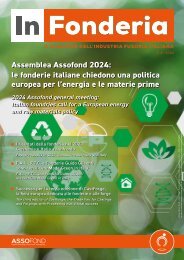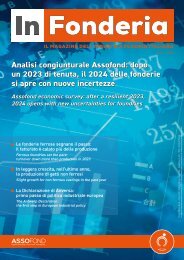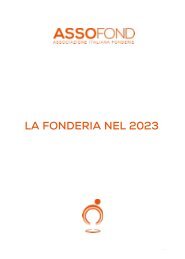In Fonderia 2 2024
Secondo numero del 2024 di In Fonderia
Secondo numero del 2024 di In Fonderia
You also want an ePaper? Increase the reach of your titles
YUMPU automatically turns print PDFs into web optimized ePapers that Google loves.
STEEL AND ALUMINIUM: ONE GOES UP, THE<br />
OTHER GOES DOWN<br />
Twenty-five years ago, the packaging chain, as<br />
contained in the report, was one of the first to<br />
be regulated at a European level with an apsuperiori<br />
al 70% del totale.<br />
Gli obiettivi sfidanti di decarbonizzazione fissati dall’Ue, del resto, stanno facendo emergere con sempre<br />
maggiore evidenza il ruolo chiave del riciclo del rottame ferroso quale risorsa strategica per la transizione e la<br />
conseguente necessità di misure che consentano di aumentarne la disponibilità e la qualità per l’industria<br />
siderurgica e fusoria europea. La capacità di produzione di acciaio da forno elettrico tenderà necessariamente<br />
ad aumentare, portandosi dietro una crescente domanda globale di rottame e in particolare IN PRIMO di rottame PIANOcon<br />
elevate caratteristiche qualitative per supportare produzioni siderurgiche e fusioni a più alto valore aggiunto.<br />
A causa della forte dipendenza dell’industria manufatturiera italiana dall’importazione dei metalli, il<br />
miglioramento della raccolta di questa frazione diverrà quindi sempre più strategico per la nostra economia.<br />
glio, forse il più difficile da superare, riguarda<br />
l’approccio normativo europeo. Bruxelles ha<br />
sempre dato più valore alle pratiche di riuso,<br />
invece che al riciclo, riducendo così in maniera<br />
significativa l’accessibilità alle materie prime<br />
secondarie. L’accordo raggiunto di recente per<br />
il nuovo Packaging & Packaging Waste Regulation<br />
(Ppwr) sembra essere un compromesso<br />
valido. Tuttavia, il problema resta. Riuso versus<br />
riciclo non è sinonimo di sana concorrenza,<br />
bensì uno scontro interno all’Ue, che non fa<br />
bene a nessuno.<br />
ACCIAIO E ALLUMINIO: CHI SCENDE E CHI<br />
SALE<br />
La filiera degli imballaggi, come si legge nel<br />
rapporto, è stata tra le prime, venticinque<br />
anni fa, ad essere normata a livello europeo<br />
con un approccio che oggi possiamo definire<br />
di economia circolare ante litteram. Secondo<br />
le ultime stime del Conai, per il <strong>2024</strong> si ipotizza<br />
che la percentuale di riciclo degli imballaggi<br />
in Italia possa arrivare a sfiorare il 75%: oltre<br />
10.300.000 tonnellate di rifiuti di imballaggio<br />
troveranno una seconda vita, ossia il 74,9%<br />
dell’immesso al consumo, che quest’anno si<br />
prevede pari a circa 13 milioni e 900.000 ton-<br />
(batteries and solar panels) and strengthen<br />
the secondary raw materials markets, so as<br />
to reduce consumption of primary raw materials.<br />
It is also necessary to tackle the issue of<br />
production costs. <strong>In</strong> fact, the recycling chain is<br />
energy-intensive, and as such, it has paid the<br />
price in recent years of the Russia-Ukraine war<br />
and its production costs are only now starting<br />
to go back to normal, albeit to levels higher<br />
than those of 2022. The final hurdle, and<br />
perhaps the hardest to clear, is the European<br />
regulatory approach. Brussels has always put<br />
greater value on reuse rather than on recycling,<br />
thus significantly reducing accessibility to<br />
secondary raw materials. The agreement recently<br />
reached for the new Packaging & Packaging<br />
Waste Regulation (Ppwr) seems to be a<br />
valid compromise. However, the problem still<br />
remains. Reuse against recycling is not a synonym<br />
for healthy competition, but a clash within<br />
the EU, which does no one any good.<br />
<strong>In</strong> <strong>Fonderia</strong><br />
13














